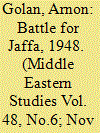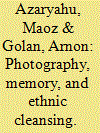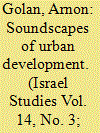|
|
|
Sort Order |
|
|
|
Items / Page
|
|
|
|
|
|
|
| Srl | Item |
| 1 |
ID:
142759


|
|
|
|
|
| Summary/Abstract |
The 1948 war resulted in a sweeping spatial transformation of areas included in the bounds of the newly formed Jewish state, including that of the western Jerusalem. Arab neighbourhoods were almost totally depopulated during fighting and shortly after resettled by Jews, most of which has been war refugees from Jerusalem's Jewish neighbourhoods or newly arrived immigrants. The effect of war on human spatial structures is in many cases abrupt and sweeping. Yet, due to the limited use of heavy weaponry by both belligerent sides, the damage to built-up structures and infrastructure systems was not inclusive. Repopulation of former Arab areas by Jews was of large scale and carried out by different local and national institutions. Yet it seems as in many cases it was personal initiatives, especially of war refugees that sought for alternative housing that had a crucial effect over the newly formed settlement pattern. One way or another, the spatial structure of Jerusalem that was formed in decades of urban dynamic development was drastically transformed after a short period of fighting between December 1947 and early 1949, that affects the spatial structure of Israel's capital city until now.
|
|
|
|
|
|
|
|
|
|
|
|
|
|
|
|
| 2 |
ID:
115335


|
|
|
|
|
| Publication |
2012.
|
| Summary/Abstract |
Modern armies conduct military operations in urban areas, but rarely do so willingly. Military commanders prefer fighting in open terrain in which forces freely maneuver and use firepower, rather than in urban areas in which obstacles such as tall buildings, narrow streets, and non-combatants hinder control of the battlefield. Most professional military literature recommends refraining from fighting in urban areas and considering urban battles an unfortunate aberration to be avoided in the future. Deliberate choice of an urban battlefield is quite exceptional, deriving mostly from strategic needs or due to the symbolic value ascribed to a particular city or town. Most decisive battles of the first Arab-Israeli war in 1948 were fought in open areas. However, strategic and political considerations, as well as cultural and sentimental, caused both sides to fight in cities and towns, such as in the case of Jaffa and Tel Aviv metropolitan area, Palestine's major economic center and a main road junction. Both cities also held sentimental value: the dynamically developing modern Jaffa was a symbol of an emerging Palestinian nation while Tel Aviv, the "first Hebrew city," was the Zionist ideal of urban development.
|
|
|
|
|
|
|
|
|
|
|
|
|
|
|
|
| 3 |
ID:
112532


|
|
|
|
|
| Publication |
2012.
|
| Summary/Abstract |
Much of the recent academic literature on the 1948 war portray it a one-sided-and thus simplistic-ethnic cleansing of the Arab population of Palestine. Referred to as the Naqba paradigm, it features the Jews/Zionists as villainous perpetrators and the Palestinian Arabs as feeble victims. Accordingly, the story of "the 1948 Ethnic Cleansing of Palestine" excludes expulsion and massacres of Jews, the destruction of Jewish communities, and the erasure of the Jewish signifiers in the local landscape from the story. As made explicit in John Phillips' photo-reportage featuring the destruction of the Jewish Quarter of the Old City of Jerusalem, the ethnic cleansing of Palestine also involved the expulsion of Jews and the destruction of their communities-whenever and wherever military power relations were in favor of Arab forces.
|
|
|
|
|
|
|
|
|
|
|
|
|
|
|
|
| 4 |
ID:
091099


|
|
|
|
|
| Publication |
2009.
|
| Summary/Abstract |
This article explores the issue of noise in the formation of Tel-Aviv's soundscapes in the 1920s and the 1930s. Underlying the article are the debates and conflicts over regulation and control of urban soundscapes that were an aspect of Tel-Aviv's urban growth. The analysis is based on letters of complaint sent to the municipality. These letters document different types of noise that bothered residents of the city during this period as well as social norms and cultural conventions deemed by residents and municipal authorities as constitutive of public order.
|
|
|
|
|
|
|
|
|
|
|
|
|
|
|
|
|
|
|
|
|